Physical Address
304 North Cardinal St.
Dorchester Center, MA 02124
Imaging the postoperative knee can be challenging. The postoperative knee can have all of the pathologic processes of the preoperative knee, in addition to specific issues related to the surgery performed, general problems with surgery, and specific postoperative complications. The imaging is often confounded by artifact produced from instrumentation or surgical scar, so that, often, special imaging technique is required, especially for CT and MRI. Because imaging is used to answer clinical questions, knowledge of the procedures performed and the reason for the postoperative imaging can be very helpful and important in interpreting studies. If not provided on the ordering physician's request, this information usually can be obtained with a telephone call. Because surgical procedures have evolved and continue to evolve, it helps to have a working knowledge of these procedures and interaction with the referring physician who fosters that knowledge.
The discussion in this chapter is on some of the postoperative findings one may encounter. The emphasis is on MRI because that is the modality most commonly used. Radiography, fluoroscopy, CT, ultrasonography, and nuclear imaging also have roles for some postoperative issues.
Arthroscopy is the technique of percutaneous visualization of a joint. By adapting a cystoscope, Takagi, a Japanese surgeon, first used arthroscopy in the early 1900s to diagnose tuberculosis of the knee. His student Wantanabe worked on the technique, producing the first modern arthroscope in the late 1950s. With the advent of fiberoptics and improvement of cameras, arthroscopy became much better in the 1970s and widely used in the 1980s.
Before good noninvasive diagnostic procedures became available, arthroscopy was used as a diagnostic tool. Now it is commonly used to perform therapeutic interventions and has largely replaced arthrotomy for many operative procedures in the knee. It has the advantages of reduced morbidity and shorter recovery times.
Some of the procedures that are commonly performed through an arthroscope include cruciate ligament reconstructions, meniscectomies and meniscal repairs, chondroplasty, removal of intraarticular bodies, and removal of other masses.
The importance of knowing if arthroscopy has been performed lies in the need to know whether a finding on the study is postsurgical. For example, if a meniscus is small, and no surgery was performed, a more thorough search for a displaced flap will ensue.
On radiography, it is impossible to tell that arthroscopy has been performed unless there has been some kind of instrumentation. On MRI, arthroscopic portals cause a scar that appears as low signal on all pulse sequences ( eFig. 110-1 ). They are characteristic in location in the medial and lateral aspects of the infrapatellar fat. Evidence of whatever procedure was performed through the arthroscope may also be seen.
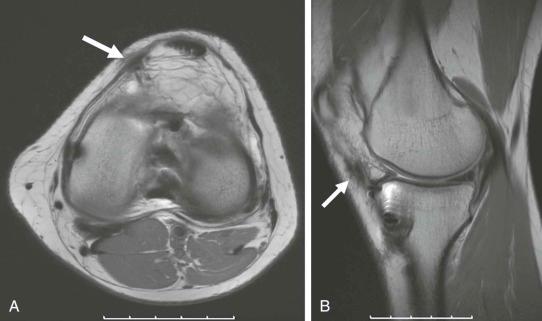
Whenever a foreign body is placed in a joint, the potential for infection exists. The appearance of septic arthritis is described elsewhere and has the same appearance in the postoperative as well as the native state—effusion with rapidly progressive joint space narrowing on the radiograph with eventual resorption/destruction of subchondral bone. The MRI features of infection are effusion with synovitis and reactive abnormal signal in the surrounding tissues. Noninfectious inflammatory arthropathy does not generally cause the degree of soft tissue signal abnormality on MRI.
Occasionally, an arthroscopic portal is placed through a portion of the patellar tendon. This often causes an extensive reaction in the tendon, with focal thickening on MRI ( eFig. 110-2 ).
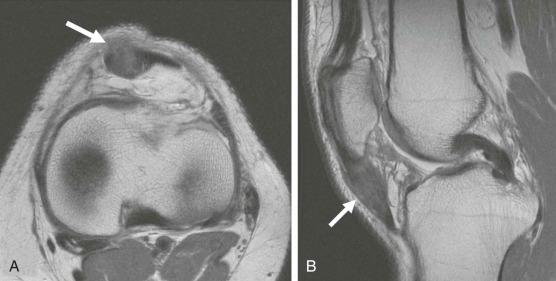
It used to be thought that patients who undergo arthroscopy can develop avascular necrosis. The theory was that the increase in pressure from the joint distention during arthroscopy could decrease blood flow and cause necrosis. More likely, the sudden new pain that patients get after arthroscopy has to do with subtle subchondral insufficiency fractures ( eFig. 110-3 ). Rarely, the arthroscope can directly hit and injure the articular surface.
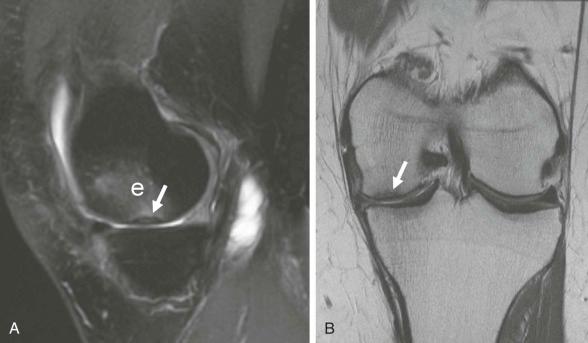
Another complication is complex regional pain syndrome, formerly known as reflex sympathetic dystrophy. Although it can occur after trauma without surgery, it may also be related to surgery ( eFig. 110-4 ).
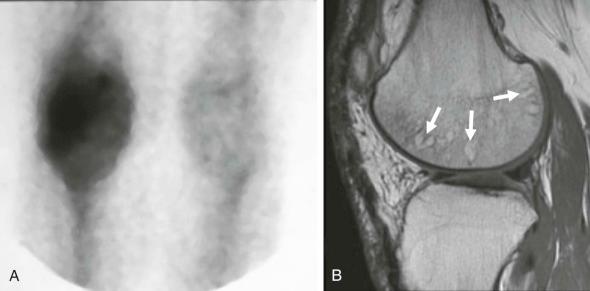
Before arthroscopy was common, orthopedic surgeons performed knee surgeries through long incisions made laterally or medially to the patella. These incisions give excellent exposure to the joint.
An arthrotomy is currently used when a procedure cannot be performed arthroscopically. Before arthroscopy became available and popular, arthrotomies were more common. Meniscectomies and reconstructions of the anterior cruciate ligament (ACL), now done arthroscopically, used to require arthrotomy.
The most common indication for arthrotomy is joint arthroplasty. Tumor resections and chondral repair and replacement procedures require arthrotomy, as does meniscal transplantation. Pigmented villonodular synovitis may require arthrotomy for complete resection, depending on the extent of disease and ability of the arthroscopist.
As with arthroscopy, an arthrotomy itself leaves no radiographic findings. It is other findings on a radiograph that indicate that arthrotomy was performed, such as the implant placed for knee replacement.
On MRI, a long vertical low signal line represents the scar left from arthrotomy ( eFig. 110-5 ). It lies either lateral or medial to the patella, depending on the approach used. The incision is long enough to be able to peel back the patella to expose the joint. With time, these scars become less conspicuous so that after many years it may be difficult to tell if an arthrotomy was performed.
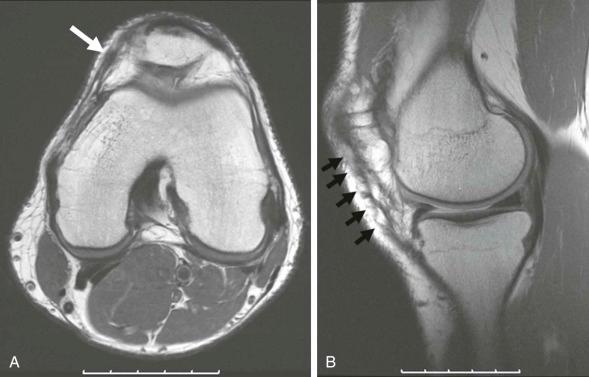
The arthrotomy itself has few associated complications. As in arthroscopy, the potential for infection exists and has the same appearance, regardless of etiology.
Tears of the anterior cruciate ligament (ACL) of the knee can lead to joint instability and subsequent arthrosis.
First repaired in 1895 and reconstructed in 1903, many materials and techniques have been used to fix ACL tears. The first patellar autograft was used in 1935. A hamstring graft followed shortly thereafter in 1939. Despite these early descriptions, people tried to primarily repair the ACL for many years afterward. Most of the primary repairs failed: only the proximal tears repaired early had success. Other than in proximal tears and bony avulsions (a minority of ACL injuries), there are reconstructions. During the 1970s, extra-articular stabilizations were used ( eFig. 110-6 ). During the 1980s, different graft materials, such as carbon fiber and Dacron, were used. Reconstructions as they are currently performed became popular in the late 1980s because of the introduction of interference screws and advances in arthroscopic surgery.

Because the ACL is the most commonly reconstructed knee ligament, surgeons are most often called upon to evaluate it. There are about 100,000 ACL reconstructions performed in the United States annually and about a 10% failure rate (often due to re-injury). Radiologists in a busy MRI practice will see many knees with ACL reconstruction for problems with the graft or a different problem in the same knee. Because they are so common, one should know how they look and what can go wrong with them.
Tears of the ACL are reconstructed in active patients whose tears cause instability that impedes normal activities for that individual. An ACL-deficient, unstable knee may, over time, progress to premature arthrosis. In patients whose knees are not unstable (because of arthritis, for example) or who are not very active, the ligament may remain torn. The purpose of the reconstruction is to restore the stabilizer of the tibia to anterior translation.
Over the years, different techniques and materials have been used for reconstructions. Artificial grafts have been used but failed because the grafts would fall apart or the body would react to them. A variety of autograft reconstructions have been used from the extra-articular ACL reconstruction (essentially a stabilization procedure that was not with an in-situ graft) to the autologous patellar tendon remaining fixated on the tibial tubercle (Marshall Mackintosh) to a variety of other autografts—iliotibial band ( Fig. 110-1 ), patellar tendon with bone plugs, or hamstring autograft. Allografts are also used (usually Achilles tendon but also patellar tendon). Rarely, the contralateral patellar tendon is used.
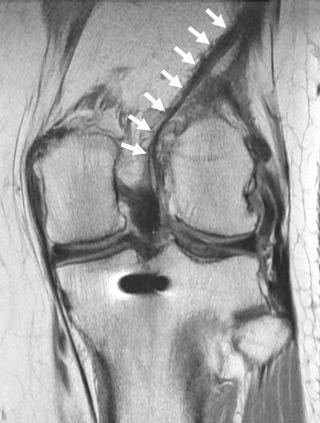
The commonly used current material is either bone-patella-bone or hamstring autograft or allograft. A variety of fixation devices are also in use: fixation screws that grab bone plug and native bone (interference screws), EndoButton (plastic buttons that hold the graft outside of the bone preventing it from sliding back), and a few other devices, including horizontal femoral fixation devices and staples ( Figs. 110-2 to 110-4 ). The interference screws can be made from metal or bioabsorbable radiolucent materials (polymers, such as polylactic acid or polyglycolic acid). They have a similar appearance on MRI, although the nonmetallic ones have less artifact.
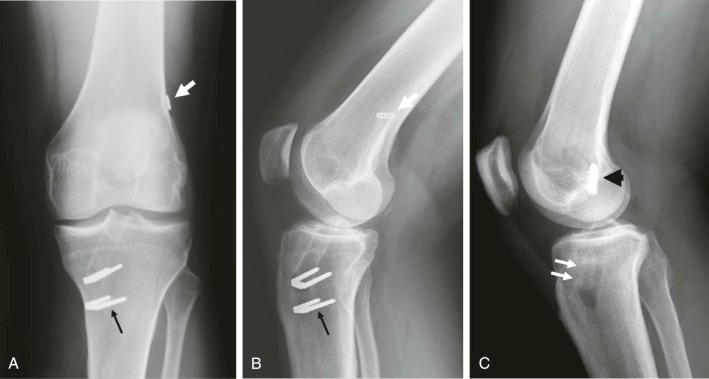
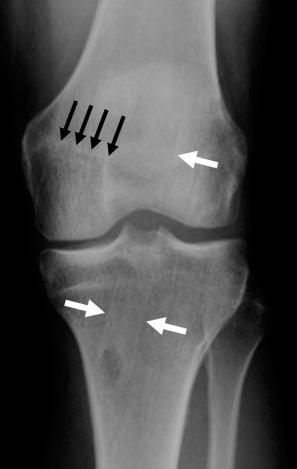
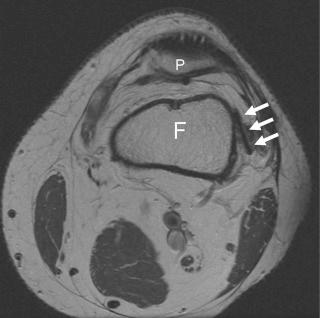
When hamstring is used, it is often folded on itself, and one can see up to four strands of tendon used for ligament reconstruction. Any of the grafts can be augmented with suture. This augmentation gives rise to a dephasing artifact that runs along the graft ( Fig. 110-5 ).

The proximal and distal ends of a graft arthroscopically placed through tunnels in the tibia and femur line up in the maximally flexed knee. The outline of the tunnels are discernible on radiography (see Fig. 110-2 ). More important than knowing what graft was used or what fixation was used is knowing its integrity and appropriateness of placement (position). Recently, some surgeons have reconstructed the two discrete bands of native ligament, yielding two separate proximal points of fixation.
Appropriate placement of the graft is important to prevent some of the complications of inappropriate placement—graft impingement, knee instability, and laxity. Whereas some surgeons are starting to use two bands of graft to better simulate the native ACL, most use one only. To mimic function of the native ligament, the tibial tunnel should be at the back of the native ACL footprint (it used to be placed more anteriorly). The femoral tunnel hugs the posterior cortex of the femur so that the graft parallels Blumensaat's line in the sagittal plane ( Fig. 110-6 ). In the coronal plane, the graft should be angled about 15 degrees to prevent the knee from turning on itself (see Fig. 110-2 ). Some surgeons place the graft a bit looser than others. This is a matter of technique and preference so that, just because a tibia appears a bit more anterior than a native ACL, it does not imply inappropriate laxity, re-tear, or misplacement. The position thought to be optimal for the tibial tunnel has moved over the years. It is now believed that the tibial graft should enter the tibia at the posterior portion of the native ligament. This practice will likely be modified with the increasing use of two bundle grafts and with further research into biomechanics.
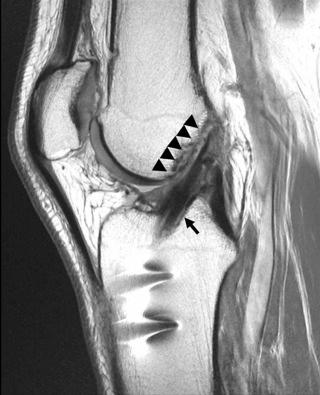
Ligament reconstructions go through a well-documented pattern of incorporation in which the graft initially serves as a stabilizer and then as a scaffold for a new fibrous support to form. For this to happen, the graft must become vascularized, resorbed to some extent, and then replaced. The MRI appearance reflects those changes.
Initially, a graft is of homogeneously low signal intensity. Over a couple of months, the graft becomes higher in signal intensity during the vascularization phase. Over 6 months to 2 years, it again becomes of homogeneously high signal intensity. During the revascularization stage, the graft is weak and susceptible to re-injury. Normally, a graft should be a continuous low signal structure (see Fig. 110-6 ).
The site of allograft harvest shows postoperative abnormalities. For patellar harvest, the defect in the central third may or may not be apposed by suture, and the patellar bone plug harvest side may or may not have bone graft placed into it. Both bone plug harvest sites are usually visible forever on the axial images. The patellar tendon is initially thick and high signal on MR and, with time, becomes more normal.
There are more subtle findings in hamstring harvest: there is loss of the semitendinosus and often the gracilis tendon with a thin, and eventually thicker, fibrous sheath over the length of the harvest ( eFig. 110-7 ). Regeneration of the tendon that results in a fibrous scar in the region from where the tendon was harvested has been described.
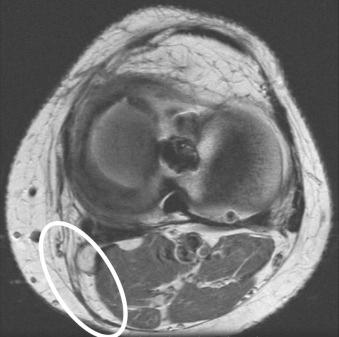
Complications of ACL grafts include problems related to placement (e.g., persistent instability or graft impingement); reactions to the graft (scar, inflammation, infection); and trauma (re-tears, degeneration, ganglion formation).
When a graft is malpositioned, impingement can occur either against the bone of the tibia or at the intercondylar notch. The graft curves around or rubs against bone. This can wear down the graft or impede its function ( Fig. 110-7 ).
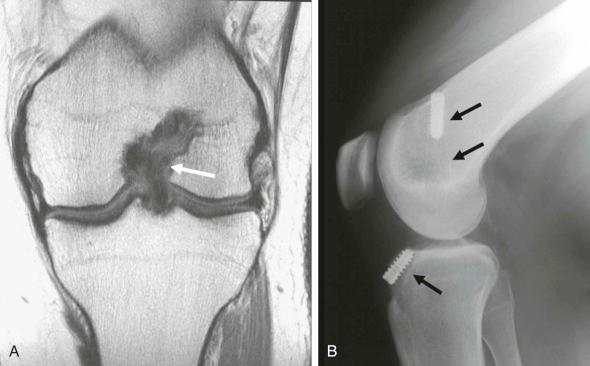
During the graft placement, some surgeons will remove some of the bone around the intercondylar notch (notchplasty) to prevent this from happening ( eFig. 110-8 ).
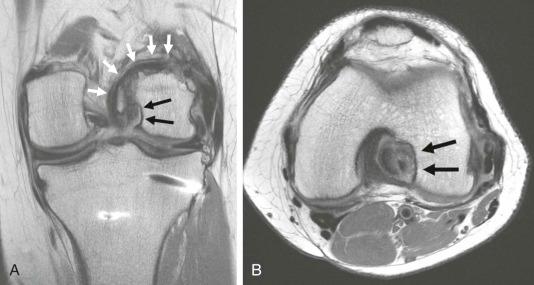
If the graft is too vertical, the knee will be unstable to rotation and the femur and tibial can twist on each other ( eFigs. 110-9 and 110-10 ).
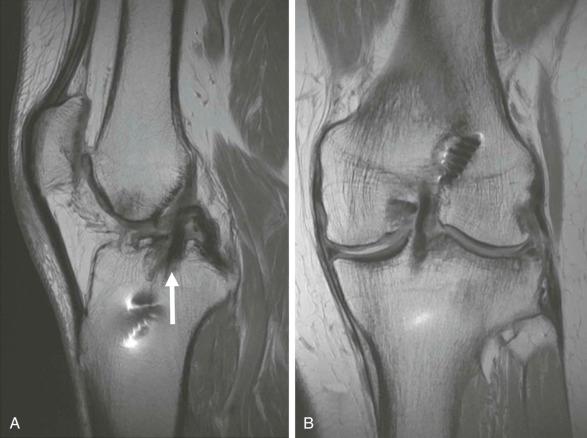
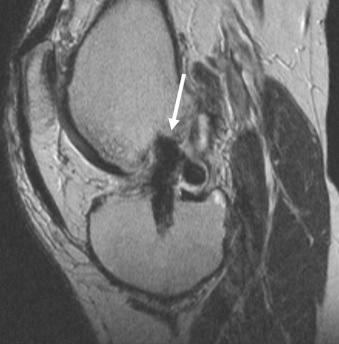
Focal scar formation in the intercondylar notch can block terminal extension and cause pain. This phenomenon is the so-called Cyclops lesion because of its similar appearance to the single eye of the Cyclops. This lesion may be related to inadequate removal of the native ACL or simply exuberant inflammatory response ( Fig. 110-8 ). More extensive inflammatory response can lead to arthrofibrosis, which is characterized on MRI as low signal intensity tissue replacing the infrapatellar fat and extending from the femoral trochlea to the patella and patellar tendon ( Fig. 110-9 ). Clinically, these involved knees will be painful and have limited flexibility.
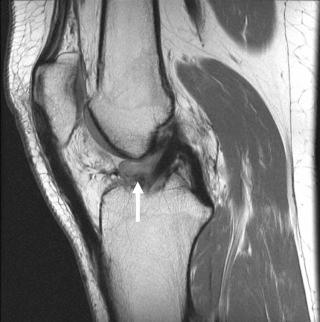
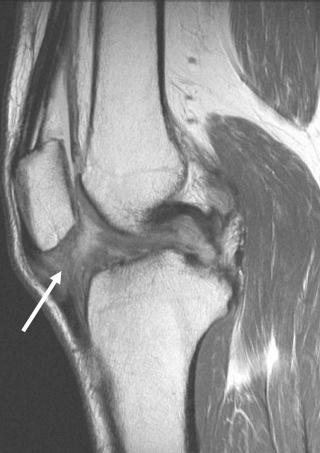
Some patients develop an inflammatory reaction to the graft. This traditionally was a greater problem with synthetic grafts because there would be bone resorption and the tunnels would widen. This same phenomenon occasionally happens with allografts. In this circumstance, it can be difficult to differentiate this inflammatory reaction from infection. The graft and tunnels show high signal intensity, and the knee has a generalized inflammatory response, with joint effusion and synovitis being the most prominent features. The diagnosis of infection can best be confirmed with joint aspiration ( eFigs. 110-11 and 110-12 ).
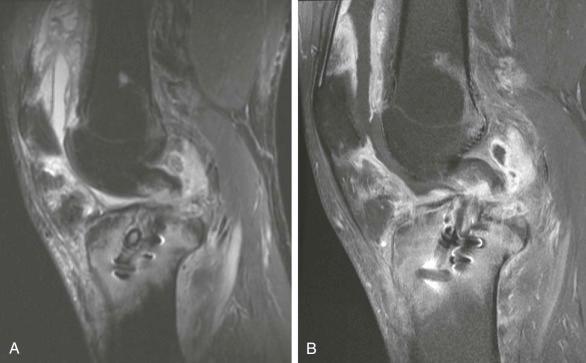
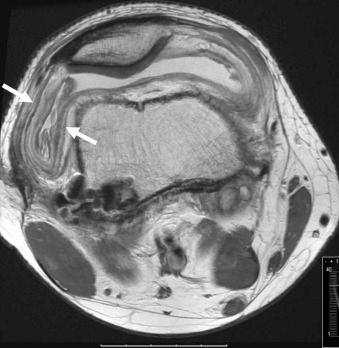
Like the native ligament, one can perceive tears—both partial and complete. They are evaluated in the same way as for the native ligament, looking for contiguous low signal fibers ( eFig. 110-13 ). As with the native ligament, ganglia can form in the reconstructed ligament. These ganglia (fluid signal regions) can extend into the bone tunnels and cause widening of the tunnel ( eFig. 110-14 ). Other pathologic processes that occur in the unoperated knee, such as stress fractures, are also “fair game” for the postoperative knee ( eFig. 110-15 ).
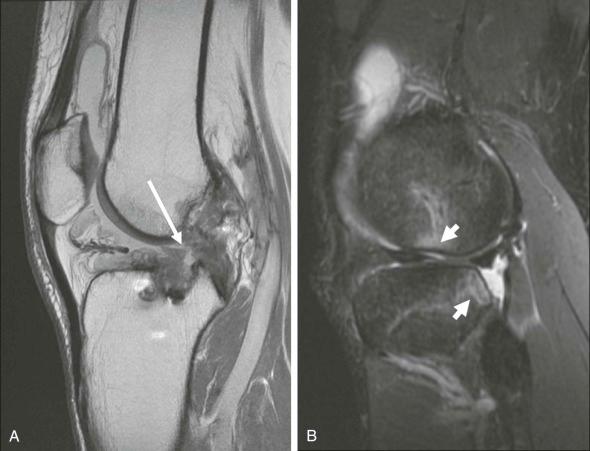
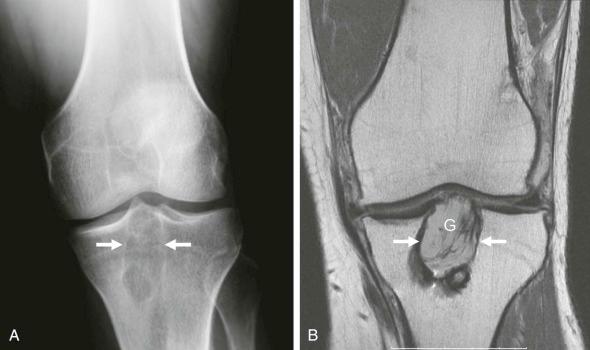
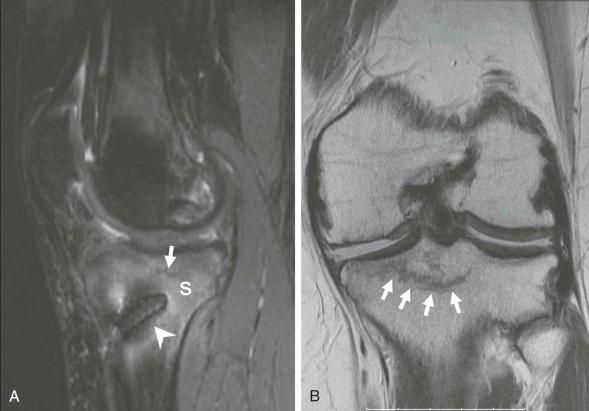
Posterior cruciate ligament (PCL) tears are less common than ACL tears. The PCL stops posterior translation of the tibia, and tears most commonly occur from direct impaction of the tibia with the knee flexed (the so-called dashboard injury). Hyperextension and knee dislocation are the other major mechanisms of injury to the PCL.
PCL reconstruction can be performed using a one- or two-bundle technique ( Fig. 110-10 ). Two bundles are more commonly used for the PCL than for the ACL reconstruction.
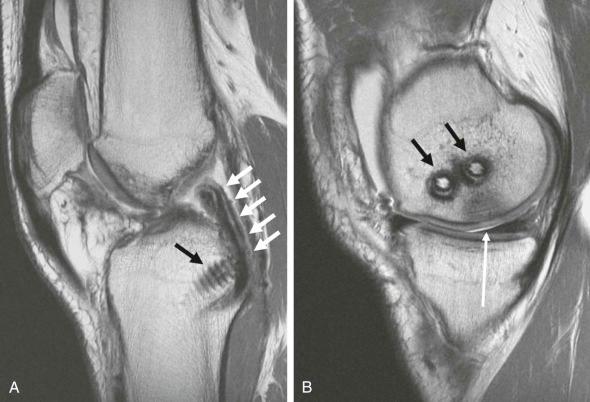
As with ACL tears, instability can lead to arthrosis. To prevent this, reconstruction of the ligament is performed. Isolated posterior cruciate ligament (PCL) tears may not be fixed, especially in an older or inactive individual.
PCL reconstruction is less common but has a similar appearance to ACL reconstruction. More often, with the PCL reconstruction, two bands are used with slightly different insertion points on the femur. The ligaments themselves should maintain the same signal as the ACL and be of homogeneously low signal intensity and continuous.
The complications of PCL reconstruction are the same as those associated with ACL reconstruction: infection, graft re-tear, and malposition. Arthrofibrosis and intercondylar notch scarring are not as common.
Tears of the medial collateral ligament (MCL) are common sports injuries. The ligament usually heals without help, but repair/reconstruction is sometimes necessary.
Autograft reconstruction of the medial collateral ligament (MCL) was first reported in 1914. The common technique currently used was published by Bosworth in 1952 and is referred to as the Bosworth procedure.
Because most tears heal on their own, surgeons see relatively few repairs and reconstructions. As with the ACL, primary repairs are less common than reconstructions. The setting for reconstruction is usually that of an unstable knee, such as in multiple ligament injuries. Occasionally, patients who have ACL and MCL tears will have the MCL reconstructed if the surgeon thinks the knee is too unstable to valgus load after the ACL reconstruction. Sometimes, high-performance athletes with repeated MCL injury will undergo ACL reconstruction.
The healing MCL can be quite thick and exhibit high signal intensity on MRI. A reconstructed ligament will have either interference screws or staples in the medial femoral condyle related to the surgery. The fixation devices (or holes associated with them), but not the ligament, are visible on radiography. On MRI, the reconstructed ligament can be thick but should be low in signal and continuous. On ultrasonography, it should also be continuous and show homogeneous echogenicity.
As with other ligaments, re-tear and failure of fixation are the most common complications. Failure is rare, and the MRI findings of a re-tear or a discontinuous or thick ligament are the same as in a torn native MCL.
The important implication of posterolateral corner injuries of the knee is relatively recent, as is their repair or reconstruction. The anatomy is complex, and it is only with improvements in MRI technique and therapeutic arthroscopy that the details of these injuries have been elucidated.
The need for repair or reconstruction of the posterolateral corner of the knee (posterior capsule, popliteofibular ligament, popliteus tendon, lateral collateral ligament, biceps femoris, and lateral meniscus) derives from preventing instability and preserving other ligament repairs. Posterolateral corner injury and instability can result in ACL reconstruction failure. To prevent this, for high-grade injuries, the posterolateral corner is augmented, repaired, or reconstructed. The need for repair or reconstruction can be made after the ACL is treated. The surgeon examines the knee for stability in the operating room to determine whether the posterolateral corner needs attention. Isolated posterolateral injuries are rarely severe enough to require ligament or tendon repair or reconstruction.
There are various techniques for providing more stability to the posterolateral corner. An anatomic reconstruction requires an allograft tendon to be placed and fixed along the lines of the native structures. As many as three grafts can be placed for reconstruction ( eFig. 110-16 ). As with the grafts described previously, they should be of low signal intensity and continuous. Because they do not always perfectly follow the native structures, a simple description of the course and assessment of integrity suffices because there is often significant associated scar tissue.
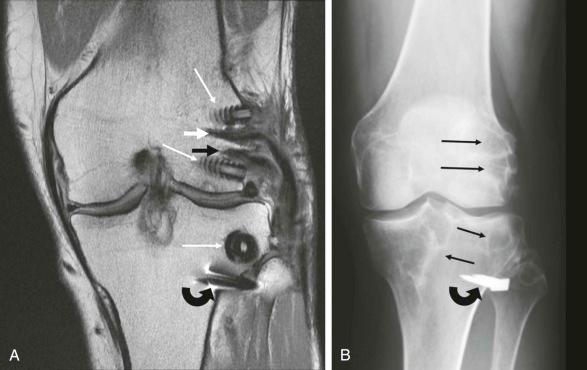
Reconstruction of the lateral structures is often combined with reconstruction of the ACL ( Fig. 110-11 ).
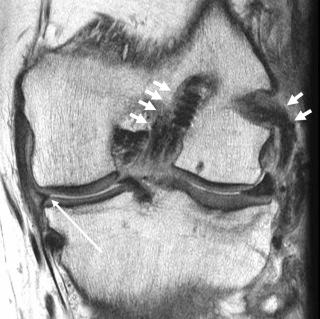
Whereas hardware failure and re-injury would be the most common complications, other typical problems, such as infection, may also occur. As with all surgeries, there may be an inflammatory or granulomatous reaction to the graft or suture.
Severe trauma, such as knee dislocations, can injure many structures and render the knee unstable. For any hinged joint, if both collateral ligaments are torn, the cause is likely to be dislocation.
To restore stability in a joint where many structures have been injured, many structures need to be repaired. Multiple ligament reconstructions can be difficult. From an imaging standpoint, one need merely to evaluate each structure and its integrity, as described earlier.
The expected appearance of a multiligament reconstruction is a composite of the individual ligaments. They should all be anatomic in position and continuous. On MRI, they are of low signal intensity. On radiography, the fixation devices should not extend into the joint or excessively into the soft tissues.
Complications have also been discussed previously and include poor graft placement, re-injury, infection, and reactive scar formation, none of which is specific to multiligament reconstruction.
Meniscectomy is the process of removing a portion or all of a meniscus. Partial removal, the process of shaving an irregular edge, may simply be referred to as débridement. Meniscal resections are commonly performed arthroscopically, but, in the past, they required an open procedure through an arthrotomy.
Meniscal tears are common and can be caused by both degenerative and traumatic processes. The tears can cause pain, catching, and clicking. Displacement of potions of the torn meniscus can cause locking of the knee or the inability to flex or extend the knee.
Because the meniscus is important for the normal function of the joint—to dissipated load and add stability—surgeons try to preserve meniscal tissue. This can be done by repairing or sometimes replacing or transplanting meniscal tissue. If the meniscal tissue is abnormal, is thought to be the source of the patient's symptoms, and cannot be salvaged, it is resected. Formerly, before the importance of preserving meniscal tissue was realized, surgeons resected the entire meniscus. Now they resect only as much as they have to for relief of symptoms and restoration of function.
The appearance of the postoperative meniscus depends on the surgery performed. In partial meniscectomy, in which a portion of the meniscus is shaved to restore a smooth edge, the meniscus may simply appear smaller on MRI (see Fig. 110-11 ). If there was a large tear, such as a long oblique tear, the appearance may be that of a smaller meniscus with persistent oblique increased signal intensity in the meniscal remnant that can persist for years after surgery.
If the meniscus is severely degenerated or so extensively torn that it cannot be salvaged, all or most of the meniscus will be removed (resected).
Become a Clinical Tree membership for Full access and enjoy Unlimited articles
If you are a member. Log in here